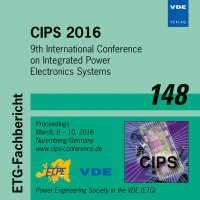Processing and Properties of Chip-bonding on Copper by Low-temperature Sintering a Nanosilver Paste
Konferenz: CIPS 2016 - 9th International Conference on Integrated Power Electronics Systems
08.03.2016 - 10.03.2016 in Nürnberg, Deutschland
Tagungsband: CIPS 2016
Seiten: 5Sprache: EnglischTyp: PDF
Persönliche VDE-Mitglieder erhalten auf diesen Artikel 10% Rabatt
Autoren:
Zheng, Hanguang; Gao, Shan; Lu, Guo-Quan (Department of Materials Science and Engineering, Virginia Tech)
Ngo, Khai; Lu, Guo-Quan (The Bradley Department of Electrical and Computer Engineering, Virginia Tech)
Inhalt:
Chip-bonding by silver sintering has emerged as a promising lead-free die-attach solution for interconnecting power devices. Most of the silver-sintering processes reported in the literature require the bonding surfaces to be either silver or gold. The bonding surfaces of power devices are normally silver; however, the surfaces of their substrates are commonly copper, which needs to be coated with silver or gold to be compatible with the reported silver-sintering processes. In this paper, we summarize our studies of a nanosilver paste for bonding power devices on an uncoated DBC substrate and a copper lead-frame with an OSP finish. A sintering profile with controlled atmosphere was developed to achieve chip-oncopper die-shear strength over 30 MPa. The nanosilver-bonded devices were evaluated for thermo-mechanical reliability by temperature-cycling and power-cycling tests. We found no significant drop in die-shear strength after 1000 temperature cycles and a power-cycling lifetime over 48,000 cycles. Microstructure of the silver-copper interface was characterized by transmission electron microscopy of a cross-section of the interface prepared by focusedion-beam micromachining. TEM imaging supports the formation of metallic bonds between copper and the sintered silver.


